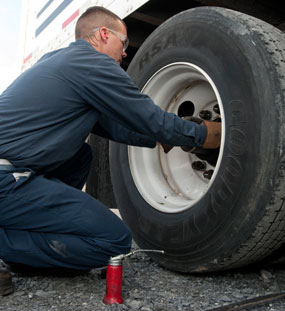Tire maintenance? What's that? Just a walk by and, yup they are still black, or are they still there? Or maybe take that mini bat and give them a good whack? That is how some drivers do it, but for a truck owner, tires are a very important part of keeping your truck in service and a large expense.
Tire maintenance? What’s that? Just a walk by and, yup they are still black, or are they still there? Or maybe take that mini bat and give them a good whack? That is how some drivers do it, but for a truck owner, tires are a very important part of keeping your truck in service and a large expense. Expenses come in many forms, from the initial purchase to reduced fuel mileage and faster wear if allowed to run low. It is also a safety issue, as a low or flat tire can blow out and cause damage to your truck or other vehicles, with possible injury. The tire industry now says if a tire is 15% low it is considered flat. A flat tire builds heat as it rolls on the road. To some extent it will gain pressure as it builds heat, but not enough to compensate for being low. In a lot of cases the tire will blow out and the result is what is left along the road.
What do you need to do tire maintenance? Two things: 1) a good tire gauge that can be calibrated, and 2) a tread depth gauge. I will add to this by saying any tire gauge is better than not having one at all. I guess you also need about 15 minutes to check your tires also, but you have to do this during your pre trip don’t you?
Simply put, tires are the most overlooked items of an inspection. At the least, tires should be checked with a gauge once a week. We have a tire pressure monitoring system on our truck; this allows us to check actual tire pressure at any time with a push of a button. For an investment of about $600, we can do a full pressure check in about 20 seconds. If we have one low, it can then be aired up to proper pressure. This system also has a warning if any tire gets low by 10%, and another warning at 25%. The warnings will come whether you are moving or sitting still. So if you run over something and get a slow leak it will tell you when it gets low so you don’t ruin a tire. The peace of mind is worth the price, plus if you save blowing out a tire – the price of a road service call to replace a blown tire can get cost more than the system.
Ok, back to the gauge. Checking tire pressure is simple. Find the valve stem – there is one for every wheel, usually in a hole in the face of the wheel. Once you locate the valve stem, remove the cap. This could be plastic, but if it is, it needs to be replaced with a metal one – DOT doesn’t like the plastic caps. Once you have the cap off, press the gauge firmly onto the open end of the stem. The reader bar will protrude from the end of the gauge telling you how much air is in the tire. Simply read the meter of the gauge, and if it is where you want it to be, put that metal cap back on and you’re done. Recommended pressures are printed on the tire sidewall. If it needs air, most truck stops have air either on the fuel island or at the shop, just ask. Just like you checked the air you put air in the tire. Remove cap, press and hold air hose chuck on the valve stem for a bit then check with your gauge again, repeat till up to pressure. If you over-fill the tire don’t worry; use your gauge and lightly press the chuck on the stem till you hear air leaking, keep doing this until down to pressure.
The tread depth gauge will let you know when to rotate or replace your tires. Tires on the steer must be replaced on or before a minimum tread depth of 4/32 and the drives or trailer tires must be replaced on or before a minimum of 2/32 or you will risk being out of service by DOT. Tires on the right side usually wear faster than the left due to the crown of the road. It is recommended that once there is more than 6/32 difference from side to side the tires need to be rotated. It’s a good idea to have the tires rebalanced while you have them off for rotating.
To use the tread depth gauge just hold the barrel of the gauge between the thumb and the middle finger, place the index finger on the end of the gauge plunger and push the plunger in. Then find the most worn spot of the tread and this is where you need to measure. With the pointed end of the gauge down, place it into the tread groove and push the barrel down. This will cause the plunger to come back out of the barrel so you can read the 32nds on the side of the plunger. Pretty simple and worth the time.
So that’s all there is to maintaining your tires, other than keeping the alignment right, you should be good to go.
Until next time, check those tires, improve your bottom line and be safe.
